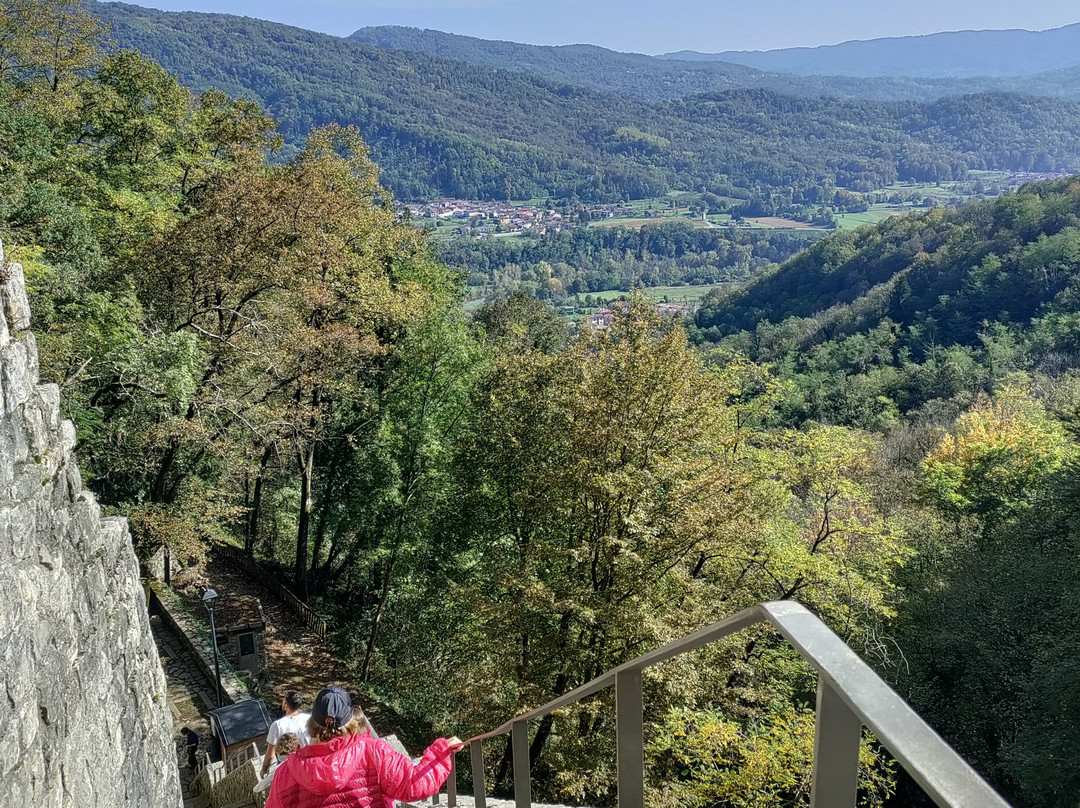的点评
A cultural jewel, key to the perception of the so-called “Italian Slavia”.
Grotta di San Giovanni d'Antro的点评
点评:A visit to this cave-church is highly recommended, if only because it allows for a true immersion in the culture of the Natisone Valleys, the easternmost tip of Friuli.
The history of this cave highlights the region’s function as a “gateway” to Italy. The legend of “Regina Vida”, who according to tradition successfully resisted here the siege of Attila, king of the Huns (therefore in the middle of the 5th century AD), simulating a completely false abundance of food for the besieged, is significant of this function of the region, as an entrance to Italy from the East. The story of the entry of the Lombards into Italy through these valleys (568AD) isn't legendary but real; and the architecture of the “Sancta Maria Antiqua” lodge in the cave bears witness to this very ancient lineage.
Finally, the personality of the valleys in recent centuries, also linked to their transit function, is well exemplified by the other salient architectural elements of the cave. The “Chapel of Saints John the Baptist and the Evangelist” in late 15th century architecture, attributable to that Gothic style that elsewhere is called “flamboyant”, almost unknown in Italy but common in nearby Slavic lands, is in fact due – as attested by an epigraph – to the “Maister Andre von Lach”, that is Škofja Loka, in what is now Upper Carniola, Slovenia. And the sumptuous wooden baroque altar in the center of the cave (early 18th century), similar to many altars scattered throughout the small churches in the area, is due to Bartolomeo Ortari from Caporetto / Jernej Vrtav from Kobarid, a town now in Slovenia as well, and at the time falling within the County of Gorizia, in turn part of the “Holy Roman Empire”.
All this effectively suggests the personality of the Natisone Valleys, and therefore of this cave-church, as a border place and at the same time a place of transit, also allowing the attentive visitor to be aware of being in the former "Italian Slavia", a region inhabited mainly by Slavs, who settled in these valleys since the early Middle Ages, and today a community well aware of its own traditions.
The history of this cave highlights the region’s function as a “gateway” to Italy. The legend of “Regina Vida”, who according to tradition successfully resisted here the siege of Attila, king of the Huns (therefore in the middle of the 5th century AD), simulating a completely false abundance of food for the besieged, is significant of this function of the region, as an entrance to Italy from the East. The story of the entry of the Lombards into Italy through these valleys (568AD) isn't legendary but real; and the architecture of the “Sancta Maria Antiqua” lodge in the cave bears witness to this very ancient lineage.
Finally, the personality of the valleys in recent centuries, also linked to their transit function, is well exemplified by the other salient architectural elements of the cave. The “Chapel of Saints John the Baptist and the Evangelist” in late 15th century architecture, attributable to that Gothic style that elsewhere is called “flamboyant”, almost unknown in Italy but common in nearby Slavic lands, is in fact due – as attested by an epigraph – to the “Maister Andre von Lach”, that is Škofja Loka, in what is now Upper Carniola, Slovenia. And the sumptuous wooden baroque altar in the center of the cave (early 18th century), similar to many altars scattered throughout the small churches in the area, is due to Bartolomeo Ortari from Caporetto / Jernej Vrtav from Kobarid, a town now in Slovenia as well, and at the time falling within the County of Gorizia, in turn part of the “Holy Roman Empire”.
All this effectively suggests the personality of the Natisone Valleys, and therefore of this cave-church, as a border place and at the same time a place of transit, also allowing the attentive visitor to be aware of being in the former "Italian Slavia", a region inhabited mainly by Slavs, who settled in these valleys since the early Middle Ages, and today a community well aware of its own traditions.
翻译:强烈推荐参观这座洞穴教堂,因为它可以让你真正沉浸在弗留利最东端纳蒂索内山谷的文化中。
这个洞穴的历史凸显了该地区作为意大利“门户”的功能。“Regina Vida”的传说,根据传统,她在这里成功抵御了匈奴王阿提拉的围攻(因此是在公元 5 世纪中叶),为被围困者模拟了完全虚假的食物充足,这充分说明了该地区作为从东方进入意大利的入口的功能。伦巴第人通过这些山谷进入意大利的故事(公元 568 年)不是传说,而是真实的;洞穴中“Sancta Maria Antiqua”小屋的建筑见证了这个非常古老的血统。
最后,最近几个世纪山谷的个性也与其过境功能有关,洞穴的其他突出建筑元素很好地体现了这一点。 “圣约翰施洗者和福音传教士教堂”为 15 世纪晚期建筑,属于其他地方被称为“华丽”的哥特式风格,在意大利几乎无人知晓,但在附近的斯拉夫地区却很常见,事实上,正如题词所证明的那样,它是由“安德烈·冯·拉赫大师”建造的,即现在斯洛文尼亚上卡尼奥拉的什科菲亚洛卡。洞穴中心的华丽木制巴洛克式祭坛(18 世纪初)与该地区小教堂中散布的许多祭坛相似,是由卡波雷托的 Bartolomeo Ortari / 科巴里德的 Jernej Vrtav 建造的,科巴里德现在也是斯洛文尼亚的一个小镇,当时属于戈里齐亚县,而戈里齐亚县又属于“神圣罗马帝国”。
所有这些都有力地表明了纳蒂索内山谷的特色,因此也表明了这座洞穴教堂作为边境地区和中转地的特色,也让细心的游客意识到自己身处前“意大利斯拉维亚”地区,这个地区主要居住着斯拉夫人,他们自中世纪初就定居在这些山谷中,如今他们是一个对自己的传统了如指掌的社区。
这个洞穴的历史凸显了该地区作为意大利“门户”的功能。“Regina Vida”的传说,根据传统,她在这里成功抵御了匈奴王阿提拉的围攻(因此是在公元 5 世纪中叶),为被围困者模拟了完全虚假的食物充足,这充分说明了该地区作为从东方进入意大利的入口的功能。伦巴第人通过这些山谷进入意大利的故事(公元 568 年)不是传说,而是真实的;洞穴中“Sancta Maria Antiqua”小屋的建筑见证了这个非常古老的血统。
最后,最近几个世纪山谷的个性也与其过境功能有关,洞穴的其他突出建筑元素很好地体现了这一点。 “圣约翰施洗者和福音传教士教堂”为 15 世纪晚期建筑,属于其他地方被称为“华丽”的哥特式风格,在意大利几乎无人知晓,但在附近的斯拉夫地区却很常见,事实上,正如题词所证明的那样,它是由“安德烈·冯·拉赫大师”建造的,即现在斯洛文尼亚上卡尼奥拉的什科菲亚洛卡。洞穴中心的华丽木制巴洛克式祭坛(18 世纪初)与该地区小教堂中散布的许多祭坛相似,是由卡波雷托的 Bartolomeo Ortari / 科巴里德的 Jernej Vrtav 建造的,科巴里德现在也是斯洛文尼亚的一个小镇,当时属于戈里齐亚县,而戈里齐亚县又属于“神圣罗马帝国”。
所有这些都有力地表明了纳蒂索内山谷的特色,因此也表明了这座洞穴教堂作为边境地区和中转地的特色,也让细心的游客意识到自己身处前“意大利斯拉维亚”地区,这个地区主要居住着斯拉夫人,他们自中世纪初就定居在这些山谷中,如今他们是一个对自己的传统了如指掌的社区。


此点评仅代表旅行者个人的主观意见,并不代表TripAdvisor以及其合作方的意见。
关于我们
|
新闻动态
|
商务合作
|
会员中心
|
业主中心
|
业主通
|
常见问题
|
意见反馈
|
联系我们
|
营业执照
© 2025 Tripadvisor 版权所有。
使用条款 |隐私政策 |网站工作原理
部分照片由 VFM Leonardo 提供。
* Tripadvisor不是旅行社,也不是旅游预订服务代理商。我们提供免费、客观、公正的旅游资讯服务。 (显示更多)
TripAdvisor LLC 既不是预订代理商,也不是旅游运营商,不会向网站用户收取任何服务费。 按照规定,在 Tripadvisor 发布机票价格、游览和旅行套餐的合作伙伴(航空公司、旅行提供商及预订代理商),其标价须包含所有费用和附加费用。 例如, 机场出入境税费、消费税与其他服务费、手续费、杂费及附加费用。 当您向我们的某个合作伙伴进行预订时,请务必查阅他们的网站以了解当地行政部门要求的所有适用费用的具体情况。 除非另有说明,机票价格通常指的是一个人的价格(以人民币计)。
为方便起见,TripAdvisor LLC 根据从我们的预订合作伙伴获取的空房率计算每个酒店的均价。 对于游览和景点来说,所显示价格通常是每位成人的最低可用价格。 对于列出的任何旅行套餐或优惠,TripAdvisor LLC 无法保证任何特定的费率或价格。 此外,酒店均价每晚会更新,并以您的首选币种表示(使用现行汇率)。 由于这些已换算的价格是预估价格,因此,有关具体金额和币种请与预订网站进行核实。
此外,TripAdvisor LLC 无法保证我们网站上宣传的价格随时有效。 标价可能需要预订一定天数才能生效,或有不可用日期、使用条件或限制。
TripAdvisor公司对外部网站的内容一概不负责。优惠价格中不含税和其他费用。
ICP证:沪B2-20200433
沪ICP备20013175号
 沪公网安备31010502005427号
沪公网安备31010502005427号鹰程信息技术(上海)有限公司
货币/国家及地区
¥CNY
中国

